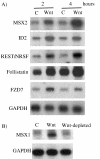A transcriptional response to Wnt protein in human embryonic carcinoma cells
- PMID: 12095419
- PMCID: PMC117803
- DOI: 10.1186/1471-213x-2-8
A transcriptional response to Wnt protein in human embryonic carcinoma cells
Abstract
Background: Wnt signaling is implicated in many developmental decisions, including stem cell control, as well as in cancer. There are relatively few target genes known of the Wnt pathway.
Results: We have identified target genes of Wnt signaling using microarray technology and human embryonic carcinoma cells stimulated with active Wnt protein. The ~50 genes upregulated early after Wnt addition include the previously known Wnt targets Cyclin D1, MYC, ID2 and betaTRCP. The newly identified targets, which include MSX1, MSX2, Nucleophosmin, Follistatin, TLE/Groucho, Ubc4/5E2, CBP/P300, Frizzled and REST/NRSF, have important implications for understanding the roles of Wnts in development and cancer. The protein synthesis inhibitor cycloheximide blocks induction by Wnt, consistent with a requirement for newly synthesized beta-catenin protein prior to target gene activation. The promoters of nearly all the target genes we identified have putative TCF binding sites, and we show that the TCF binding site is required for induction of Follistatin. Several of the target genes have a cooperative response to a combination of Wnt and BMP.
Conclusions: Wnt signaling activates genes that promote stem cell fate and inhibit cellular differentiation and regulates a remarkable number of genes involved in its own signaling system.
Figures





References
-
- Cadigan K, Nusse R. Wnt signaling: a common theme in animal development. Genes & Dev. 1997;11:3286–3305. - PubMed
-
- Bhanot P, Brink M, Harryman Samos C, Hsieh JC, Wang YS, Macke JP, Andrew D, Nathans J, Nusse R. A new member of the frizzled family from Drosophila functions as a Wingless receptor. Nature. 1996;382:225–230. - PubMed
-
- Moon RT, Brown JD, Yang-Snyder JA, Miller JR. Structurally related receptors and antagonists compete for secreted Wnt ligands. Cell. 1997;88:725–8. - PubMed
Publication types
MeSH terms
Substances
LinkOut - more resources
Full Text Sources
Other Literature Sources
Medical
Molecular Biology Databases
Research Materials
Miscellaneous

